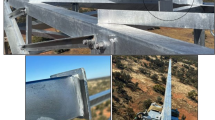Abstract
The finite element (FE) predictions of single-bolt connections shear-out failure in the literature were conducted with only elastic–plastic material models without any fracture model. This paper presents the FE single-bolt connection shear-out fracture (SBCSOF) prediction and failure analysis using the phenomenological shear fracture model. It is established that FE simulations without any fracture model employed in the literature cannot predict SBCSOF and thus cannot be employed for FE SBCSOF failure analysis. Consequently, it is essential to incorporate fracture model(s) for FE SBCSOF prediction and failure analysis. Analyses of the experimental and predicted SBCSOF shapes reveal that the shear fracture consists of a long main shear fracture which occurs under combined shear and compressive bending deformations, and a short shear lip that is oppositely inclined to the main shear fracture which occurs under combined shear and tensile bending deformations. The work thus presents the appropriate FE SBCSOF failure analysis technique that serves as a useful tool for in-service failure analysis when fractographic analysis is impracticable. The FE SBCSOF failure analysis technique could also serves as a tool for the parametric studies of connection parameters on the fracture behavior of single-bolt shear connections that exhibit the shear-out fracture mode.








Similar content being viewed by others
References
A.M. Kanvinde, G.G. Deierlein, Finite-element simulation of ductile fracture in reduced section pull-plates using micromechanics-based fracture models. J. Struct. Eng. 5, 1–39 (2007). https://doi.org/10.1061/(ASCE)0733-9445(2007)133
F. Liao, W. Wang, Y. Chen, Ductile fracture prediction for welded steel connections under monotonic loading based on micromechanical fracture criteria. Eng. Struct. 94(1), 16–28 (2015)
G.F. Vander Voort, in Visual Examination and Light Microscopy. ASM Handbook, vol 12, Fractography (ASM International, Materials Park, Ohio, 1987), pp. 91–165
K.K. Adewole, S.J. Bull, Finite element failure analysis of wires for civil engineering applications with various crack-like laminations. Eng. Fail. Anal. 60, 229–249 (2016)
K.E. Bartha, J.G. Orbison, R. Nukala, Behavior of steel tension member subjected to uniaxial loading. J. Constr. Steel Res. 58(5), 5–8 (2002)
T. Kim, H. Kuwamura, Finite element modelling of bolted connections in thin-walled stainless steel plates under static shear. Thin Walled Struct. 45, 407–421 (2007)
H. Draganić, T. Dokšanović, D. Markulak, Investigation of bearing failure in steel single-bolt lap connections. J. Constr. Steel Res. 98, 59–72 (2014)
G. Kiymaz, Bearing strength of stainless steel bolted plates in tension. Steel Compos. Struct. 9(2), 173–189 (2009)
E.L. Salih, L. Gardner, D.A. Nethercot, Bearing failure in stainless steel bolted connection. Eng. Struct. 33, 549–562 (2011)
T. Kim, H. Kuwamura, Numerical investigation on strength design and curling effect of mechanically fastened joints in cold-formed austenitic stainless steel. Mater. Des. 32, 3942–3956 (2011)
T.S. Kim, B.S. Han, Numerical simulation and effect of curling on bolted connections in cold-formed stainless steel. ISIJ Int. 47(6), 920–929 (2007)
T.S. Kim, H. Kuwamura, S. Kim, Y.T. Lee, T. Cho, A parametric study on ultimate strength of single shear bolted connections with curling. Thin Walled Struct. 46, 38–53 (2008)
T.S. Kim, H. Kuwamura, S. Kim, Y.T. Lee, T. Cho, Investigation on ultimate strength of thin-walled steel single shear bolted connections with two bolts using finite element analysis. Thin Walled Struct. 47, 1191–1202 (2009)
P. Moze, D.A. Beg, Complete study of bearing stress in single-bolt connections. J. Constr. Steel Res. 95, 126–140 (2014)
Simulia, in Abaqus documentation, Abaqus Incorporated, Dassault Systemes 2007
H. Hooputra, H. Gese, H. Dell, H.A. Werner, Comprehensive failure model for crashworthiness simulation of aluminium extrusions. Int. J. Crashworthiness 9(5), 449–464 (2004)
K.K. Adewole, L.H. Teh, Predicting steel tensile responses and fracture using the phenomenological ductile shear fracture model. J. Mater. Civ. Eng. ASCE 29(2), 06017019-1-6 (2017). https://doi.org/10.1061/(ASCE)MT.1943-5533.0002094
K.K. Adewole, F.A. Olutoge, Numerical prediction of structural steel flat and slant fracture modes using phenomenological shear fracture model. J. King Saud Univ. Eng. Sci. (2017). https://doi.org/10.1016/j.jksues.2017.11.001. (in press)
Y. Wang, L.G. Lyu, J.Y.R. Liew, Behavior of single-bolt bearing on high strength steel plate. J. Constr. Steel Res. 137, 19–30 (2017)
P. Moze, D. Beg, High strength steel tension splices with one or two bolts. J. Constr. Steel Res. 66, 1000–1010 (2010)
K.K. Adewole, Identification of appropriate micromechanical fracture model for predicting fracture performance of steel wires for civil engineering applications. Glob. J. Res. Eng. Civ. Struct. Eng. 13(3), 24–34 (2013)
K.K. Adewole, S.J. Bull, Prediction of the fracture performance of defect-free steel bars for civil engineering applications using finite element simulation. Constr. Build. Mater. 41, 9–14 (2013)
P. Rakesh, S.K. Dubey, K.K. Pathak, Effect of depth to span ratio on the behaviour of beams. Int. J. Adv. Struct. Eng. 6, 56 (2014)
P. Gillstrom, M. Jarl, Mechanical descaling of wire rod using reverse bending and brushing. J. Mater. Process. Technol. 172(3), 332–334 (2006)
Author information
Authors and Affiliations
Corresponding author
Electronic Supplementary Material
Below is the link to the electronic supplementary material.
Rights and permissions
About this article
Cite this article
Adewole, K.K., Adesogan, S.O. Finite Element Single-Bolt Shear Connection Shear-Out Fracture Failure Analysis. J Fail. Anal. and Preven. 18, 659–666 (2018). https://doi.org/10.1007/s11668-018-0457-x
Received:
Published:
Issue Date:
DOI: https://doi.org/10.1007/s11668-018-0457-x




